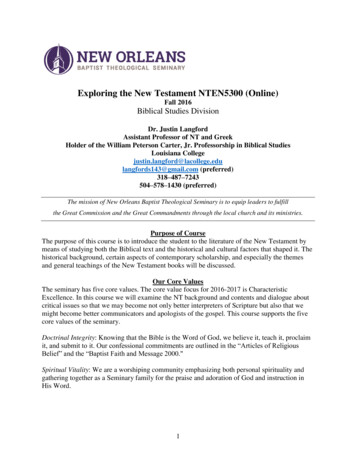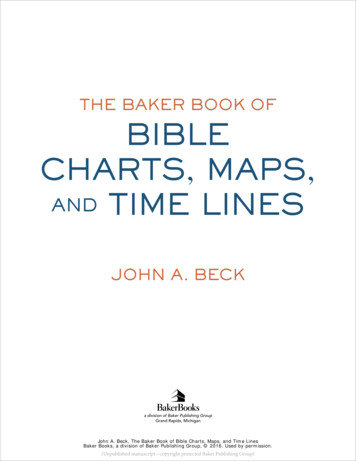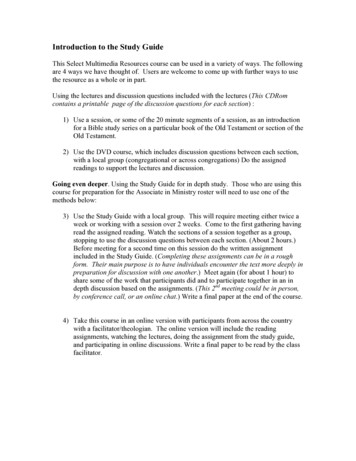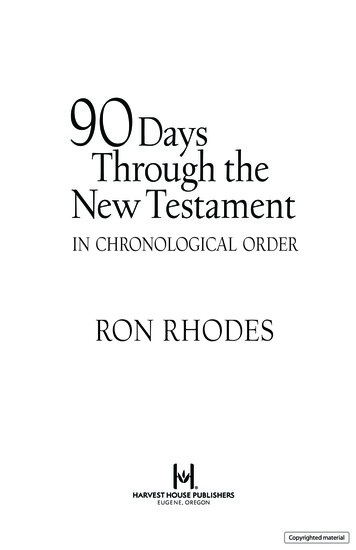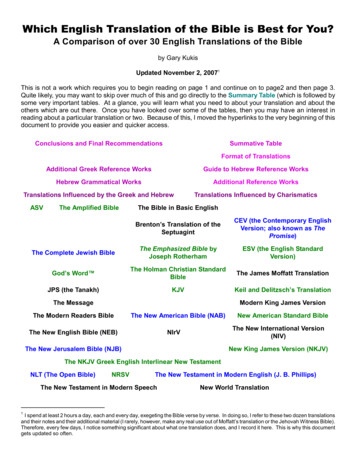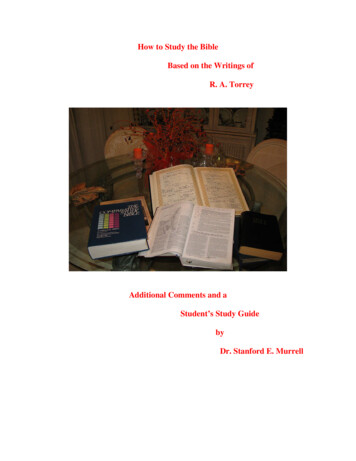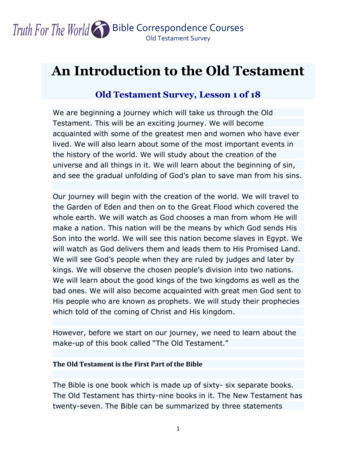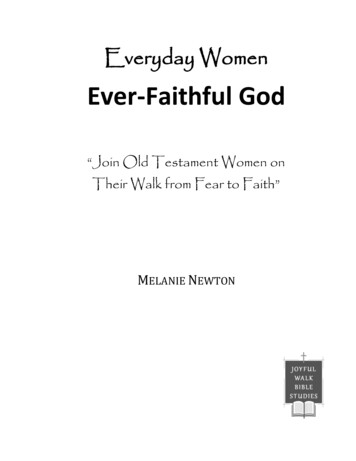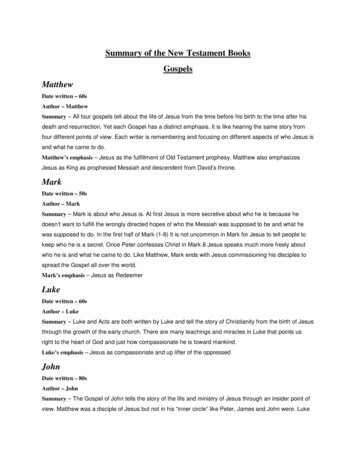
Transcription
Summary of the New Testament BooksGospelsMatthewDate written – 60sAuthor – MatthewSummary – All four gospels tell about the life of Jesus from the time before his birth to the time after hisdeath and resurrection. Yet each Gospel has a distinct emphasis. It is like hearing the same story fromfour different points of view. Each writer is remembering and focusing on different aspects of who Jesus isand what he came to do.Matthew’s emphasis – Jesus as the fulfillment of Old Testament prophesy. Matthew also emphasizesJesus as King as prophesied Messiah and descendent from David’s throne.MarkDate written – 50sAuthor – MarkSummary – Mark is about who Jesus is. At first Jesus is more secretive about who he is because hedoesn’t want to fulfill the wrongly directed hopes of who the Messiah was supposed to be and what hewas supposed to do. In the first half of Mark (1-8) It is not uncommon in Mark for Jesus to tell people tokeep who he is a secret. Once Peter confesses Christ in Mark 8 Jesus speaks much more freely aboutwho he is and what he came to do. Like Matthew, Mark ends with Jesus commissioning his disciples tospread the Gospel all over the world.Mark’s emphasis – Jesus as RedeemerLukeDate written – 60sAuthor – LukeSummary – Luke and Acts are both written by Luke and tell the story of Christianity from the birth of Jesusthrough the growth of the early church. There are many teachings and miracles in Luke that points usright to the heart of God and just how compassionate he is toward mankind.Luke’s emphasis – Jesus as compassionate and up lifter of the oppressedJohnDate written – 80sAuthor – JohnSummary – The Gospel of John tells the story of the life and ministry of Jesus through an insider point ofview. Matthew was a disciple of Jesus but not in his “inner circle” like Peter, James and John were. Luke
and John were not part of Jesus’ 12 disciples. So John holds a special place in teaching us about Godand Christ as an “insider.” One things you will notice in John are a lot of double meanings that often leavepeople confused (being born again is one example from John 3). Like the other three Gospels, Johnshows Jesus on his way to a cross. Like the other Gospels Jesus defeats death through his resurrectionand shows us that there is hope beyond the grave.John’s emphasis – Jesus as the Son of God and his unique relationship with His Father.HistoryActs of the ApostlesDate written – 62Author – LukeSummary – Luke wrote the book of Acts to tell the rest of the story. Acts covers the first thirty years of thechurch and tells how the Gospel went from being believed by just a few disciples waiting in Jerusalem tothe Holy Spirit inspiring them to convert thousands and take the message all over the world. In the bookof Acts we see missionaries including Paul, Barnabas, Mark and Luke (who both wrote the Gospels)travelling around the world, spreading the message of Christ to Jews and Gentiles. They travel to many ofthe cities Paul later writes the letters that follow.One major dividing line in the book is Acts 10 where God allows the message of Christ to be preached tothe Gentiles for the first time. This had been God’s plan all the way back to Abraham when he promisedAbraham he would be the “father of many nations” (Genesis 17:5).Paul’s LettersRomansDate written – 55Author – PaulSummary – Romans was written to a racially divided church. The Jew and Gentile Christians werestruggling to find unity. Paul writes Romans to reconcile their relationships and to understand that themessage of Christ should act as a common bond across all nations just as God planned for it to do fromthe beginning.1 CorinthiansDate written – 54Author – PaulSummary – Corinth is a town in Greece where Paul visited in Acts 18. The Corinthian church was alsovery divided (1:10-17). Paul sets them straight by talking about how true leaders should bring unity andnot division but that ultimately our leader is Christ and not any earthly leaders. Paul also deals with many
of their specific concerns as a congregation including marriage (chapter 7), the eating of food sacrificed toidols (chapters 8-11) and issues in worship (chapters 11-14).2 CorinthiansDate written – 55Author – PaulSummary – 2 Corinthians seems to be about Paul’s defense of his ministry to those hostile toward him atCorinth. He upholds his integrity and commission from God and defends many of his travel plans in thisletter.GalatiansDate written – 48Author – PaulSummary – Galatians was written to address a specific concern among the Christians in the region ofGalatia. It seems those who were Jewish Christians were beginning to enforce various aspects ofJudaism (circumcision for one) on the Gentile Christians. Paul writes this letter to assure them of thesufficiency of Christ apart from the Law of Moses (Genesis-Deuteronomy) and to help mend the brokenrelationships left behind between the Christians in the Galatian churches.EphesiansDate written – 60Author – PaulSummary – One of four letters Paul wrote from prison. Normally Paul’s letters have a specific occasionthat prompted him to write these churches. Ephesians is the hardest to pin down. What stands out inEphesians is the connection between knowing God and what he has done for us (Chapters 1-3) and theresulting actions that should be in our lives in response to all God has done for us (Chapters 4-6).PhilippiansDate written – 61Author – PaulSummary – Paul invites the Philippian Christians to live their lives for Christ even if it includes suffering(Phil 1). He encourages them to imitate Christ’s humility (Phil 2) and to keep in mind the importance ofChrist (Phil 3). Even though in jail, Paul has found contentment (Phil 4:11-12).ColossiansDate written – 60Author – PaulSummary – One of four letters Paul wrote from prison. Colossians was written to help combat some falseteachings that were taking place in the house churches of Colossae. It seems some believed that it was
necessary to appease angels by doing certain religious ceremonies in order to gain entrance to thepresence of God (see especially Col 2). Paul assures them, as he did the Galatians, that we don’t needanything more than Jesus Christ to be in the proper relationship with God.1 ThessaloniansDate written – 50Author – PaulSummary – 1 Thessalonians may have been written to Christians in Thessalonica who struggled withunderstanding the second coming of Christ and what that meant for Christians who died before his return.Some believed in the early church that Christ would come back within a generation due to some of Jesus’teachings (like John 21:22). Paul encourages them toward purity, love and responsibility.2 ThessaloniansDate written – 51Author – PaulSummary – Paul wrote this letter to alleviate even more concerns they had about the return of Christ. Itseems some had taught Christ has already come back (2 Thess 2:1-2) and that there were false teachersin their midst (2:3-15). Paul writes this letter to inform and encourage them toward faithfulness so thatthey will not be led away from God through false teaching.1 TimothyDate written – 62Author – PaulSummary – 1 & 2 Timothy and Titus are called the “Pastoral epistles”. They were written by Paul to helpequip these men of God toward a more productive ministry. They were also written to help these ministersof the Gospel (Timothy and Titus) to effectively lead in the congregations they were a part of. These threeletters are very practical covering everything from how to dress to qualifications of elders and deaconsand how to treat others in the church.2 TimothyDate written – 63Author – PaulSummary – Written as Paul nears the end of his life in Roman prison. He writes this to ensure thefaithfulness of Timothy and to encourage him to finish strong just as Paul is doing himself. The mostfamous verse in this book is found in 2 Timothy 3:14-17 where Paul encourages him to study thescriptures and explains the extent of their usefulness.
TitusDate written – 62Author – PaulSummary – The last of Paul’s pastoral letters, this letter is written to give instruction to Titus on howChristians are to live and what should be taught to those in the church. Another very practical letter.PhilemonDate written – 60Author – PaulSummary – One of four letters Paul wrote from prison. This letter was written to reconcile the relationshipbetween a slave and a slave master who were both Christians in the church in Colossae. The slave,Onesimus, came to Paul so he could help him make things right again with his master, Philemon. Paulput the pressure on Philemon to make things right, even if it wasn’t easy.General LettersHebrewsDate written – between 60 & 70Author – UnknownSummary – Hebrews reads more like a sermon than a letter and that may have been how the book ofHebrews started out. Hebrews is about the sufficiency of Christ and his exaltation above all others in allcreation. The book proves that by showing his fulfillment of many things found in the Old Testamentincluding the priesthood, sacrificial system, and many other things. This letter was undoubtedly written toa Jewish audience, who would have readily seen the connections the writer of Hebrews makes with theOld Testament.JamesDate written – 44Author – JamesSummary – James was the half brother of Jesus, sharing the same mother, Mary. James is often thoughtof as the Proverbs of the New Testament. It is very practical and easy to understand. This is a great placeto start studying the Bible if you are looking for something practical and easily applicable.
1 PeterDate written – 65Author – PeterSummary – 1 & 2 Peter were written to remind Christians of their special status with God so that theycould endure some pretty intense persecution. Peter speaks to unjust suffering and living as a Christian ina hostile world.2 PeterDate written – 65Author – PeterSummary – 2 Peter was written near the end of Peter’s life and he is calling them to the truth andreminding them of the legitimacy of the Gospel, that what Christ had done for them was real. As aneyewitness who is about to die defending his faith, he wants to make sure those he is leaving behind willhold true to the Gospel because Christ will return and Christians are called to live with that in mind.1 JohnDate written – 90Author – JohnSummary – If Timothy and Titus are pastoral letters to individuals, 1-3 John read like pastoral letterswritten in love to help them grow closer to God and to other Christians. In 1 John, John tells us what itmeans to walk in the light and just how connected our love of God is with our love for others (1 John 3).We also get more “insider” facts about who Jesus is and what he has done for us.2 JohnDate written – 90Author – JohnSummary – This letter is addressed probably to a local congregation in order to help them combat falseteaching. That false teaching had to do with whether or not Jesus really came in the flesh. John, whoknew Jesus first hand, assures them that he did.3 JohnDate written – 90Author – JohnSummary – 3 John is written toward a specific problem in a specific church. A man named Diotrepheswas causing a problem in the church and John writes to Gaius, a leader in the church, in order to help himdeal with this issue.
JudeDate written – 70Author – JudeSummary – Jude is very much like 2 Peter and is written to combat wickedness in the church. Jude usesseveral examples from scripture and Jewish tradition who did the same things and were punished byGod.ApocalypticRevelationDate written – 90sAuthor – JohnSummary – Revelation is an often misunderstood book. It was written to Christians who were undergoingsome severe persecution in order for them to have the courage to hold to their faith, even if it meant theywould die for Christ. Much of what is found in the book has already taken place but a few things still havenot. The book concludes the New Testament with a beautiful picture of how this world will end up.Everything will be made right and whole again and there will be no more pain, tears or death as we live inperfect relationship with God.
Summary of the New Testament Books Gospels Matthew Date written – 60s Author – Matthew Summary – All four gospels tell about the life of Jesus from the time before his birth to the time after his death a
